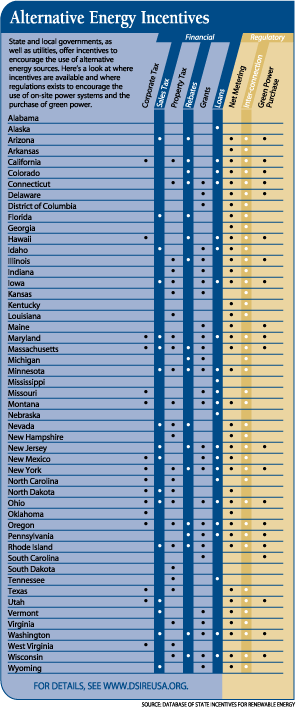Being Green Getting Easier
Financial incentives, changes in regulations and green power purchase programs offer more options for organizations that want to explore alternative energy
Interest in building, operating and maintaining facilities in ways that minimize environmental impact has skyrocketed in recent years. A growing number of green product labels, a rise in the number of government bodies requiring public buildings to be LEED-certified, and the expansion of carpet, wood and other building material recycling programs are all evidence facility executives are paying heed to the environment.
Meanwhile, other areas ripe with opportunity for a more environmentally responsible approach have languished. The thought of using alternative energy sources to power facilities, for example, has remained, for most, just a thought.
Alternative energy sources account for less than 10 percent of the total energy consumed in the country, according to the Department of Energy's Office of Energy Efficiency and Renewable Energy. Still, proponents see promise in the numbers. Although the amount of energy produced by alternative sources is small compared to the electricity that coal, natural gas and nuclear plants produce, facility executives and others are adopting the new power technologies at an increasing rate.
The Department of Energy's Solar Energy Technology program, for example, sees the use of solar power growing at a rate of 20 percent annually, while industry watchers say that 25 percent annual growth is possible.
That growth is happening for good reason. Organizations that use alternative energy sources to power their facilities achieve greater energy independence, reduce monthly energy expenses and earn appreciation from their customers for placing importance on sustainable facility practices.
“A wind turbine is a sign of action that a company takes the environment seriously,” says Heather Rhoads-Weaver, a wind energy consultant to the American Wind Energy Association.
In addition to finding that projecting an environmental image helps win customers, facility executives who use alternative power technologies discover the cost can be less than expected. A bevy of financial incentives exist to help organizations take some of the burn out of purchasing wind, solar and other alternative power technologies. Utilities offer rebates. States offer grants. The federal government offers tax incentives.
Buying Green Power
Facility executives interested in purchasing green power, but not necessarily producing it on site, can do so through utility power purchase programs available in some areas. Although only five states — Iowa, Minnesota, Montana, New Mexico and Washington — require utilities to offer green power purchase programs, an additional 19 have utilities that provide the option.
For an additional charge, typically assessed on a kilowatt-usage basis, facility executives can pay for power produced from wind farms, hydropower plants or other environmentally sound sources. Although there’s no way to know that the electricity being fed into a facility from the utility grid was produced by a green source, participation in the program helps fund the development and maintenance of the green power infrastructure. And every kilowatt produced from a green power source is one less that needs to be produced from a fossil fuel-fired plant.
Building green on-site power
For facility executives who decide to go at it alone and install an alternative on-site power technology, one of the biggest obstacles to overcome is cost. Rebates, tax incentives and grants are a few of the tools facility executives can use to reduce the capital outlay required to purchase and install technology. Many facility executives also can maximize the amount of energy they produce and sell excess power to the utility.
Although the specifics of how much power can be sold and at what rate vary by location, 39 states have net metering laws requiring utilities to credit customers for the amount of energy produced through an on-site power system. These states require utilities to pay customers retail or wholesale prices for excess electricity generated.
Likewise, 39 states and the District of Columbia have interconnection standards designed to ease the process customers must go through to connect on-site generators to utility grids. Even in states with interconnection standards, facility executives depend on cooperation from utilities. Although the standards are helpful, says Colin Murchie, director of government affairs for the Solar Energy Industries Association, they are no guarantee that the process will be smooth.
Murchie says some utilities, such as those in New York City, Austin, Texas, and Sacramento, Calif., are helpful, while others are less so. Utilities willing to let customers interconnect with the grid are typically those whose infrastructure, including generating plants and transmission and distribution lines, is being used to maximum capacity. Such utilities can avoid costs of upgrading and expanding infrastructure by encouraging customers to use on-site power generation technologies.
Most utilities are unfamiliar with the specific applications facility executives use in on-site power applications, Murchie says, with a few that are indifferent to allowing facilities to interconnect with the power grid and a few that will be helpful.
Facility executives exploring new power technologies can select from a number of approaches aimed at reducing the environmental impact of power use or increasing the efficiency of their facilities. Technologies with the least environmental impact and those thought of as truly alternative — wind, solar and biomass — are expensive to build and create the most trepidation among facility owners regarding their reliability. On the other hand, those technologies also offer the most financial incentives to offset capital costs and, over time, are best suited to reduce monthly energy expenses.
For example, New Jersey offers facility executives the opportunity to recover as much as 70 percent of costs of installing power technologies that operate on renewable fuels or natural resources. Others states that have programs advantageous to facility executives include California, New York and Washington. Even with aggressive programs in place, however, it’s difficult to reduce payback periods of the installation of wind systems to less than five years, says Rhoads-Weaver.
In addition to the high capital cost of alternative power technologies, upwards of $1,700 per installed kilowatt for wind and $1,100 per installed kilowatt for solar, a variety of factors determine payback periods of alternative power technologies. One of the most significant is the cost of energy that facilities would be able to offset with the installation of an on-site technology.
Murchie says the common perception that solar power systems offer the best payback in the sunny southeast and southwest is often proven wrong once the existing price of utility-supplied energy is taken into account. Because energy tends to be cheap in some of the most sunny regions of the country and more expensive in the northeast, it’s often easier to cost-justify a system in an area that receives less sunshine.
“In the United States, solar systems make more sense in Albany, N.Y., than in Nevada because of electricity rates,” he says. As further evidence, Murchie cites the popularity of solar systems in Germany, Japan and other countries lying, at least in part, on latitudes north of the 48 states.
Another chief consideration when calculating payback periods of solar power systems is determining the facility system replacement and maintenance costs that will be avoided. Murchie says a facility in need of a roof replacement might be able to use a less expensive roofing system if a rooftop photovoltaic system is going on top of it.
“It really makes economic sense if you can get the solar panel to do some of the other work on the building,” Murchie says.
For wind systems, important considerations include whether facility executives can get a permit to construct a tower to house the system and whether there is enough wind in the area to make the system worth the expense. Although tower heights can vary based on wind conditions, they generally range from 80 to 100 feet for systems of 10 kilowatts or less. Larger systems need taller towers.
Rhoads-Weaver says a good place to start researching wind conditions in a given area is at the Powering America Web site (http://www.eere. energy.gov/windandhydro/windpoweringamerica/). The site allows users to select certain states to see what the average wind speeds are like in their region. An area should have at least Class Three winds, about 15 miles per hour, before being considered suitable for a wind system. Winds are rated in seven classes; higher class numbers indicate stronger winds.
If wind classifications look right, the next step is to place a monitor on a tower equivalent to the height of the proposed wind system. The monitor should record wind speeds for at least three months. If monitoring indicates that winds are not as strong as necessary, Rhoads-Weaver says, it might be worth monitoring again at a higher altitude.
The data collected should be compared to yearly wind speed information from a nearby airport to be sure that the monitoring wasn’t done during an abnormally windy or calm season. The variability of wind should also be examined. Hilly areas are often windy, but the wind could blow strong for certain periods and then not at all during others. A wind system in that type of environment wouldn’t produce the reliable power that prompts some organizations to consider an on-site system or might not produce power during peak-power demands when utility power is most expensive.
“If somebody has a windy site, it certainly is one of the most economical ways to produce power,” Rhoads-Weaver says. “But just because you have good wind doesn’t always mean it will pencil out.”
Other options
Facility executives interested in making an environmental mark with their decisions on how to power their facilities need not turn to wind, solar or other generation technologies powered with alternative fuels or natural resources. Tried-and-true technologies, including reciprocating engines and microturbines also offer options.
Using natural gas to power those generating technologies is, environmentally speaking, better than using diesel or other traditional petroleum products. For the systems to be more efficient than power from the utility, however, they should be used in a combined heat and power (CHP) system in which the waste heat from the generators is used within the facility.
Dennis Moran, director of the Center for Environmental Energy Engineering at the University of Maryland, says the results of two demonstration projects built in conjunction with the Department of Energy show CHP systems can be used to reduce cooling costs and increase the efficiency of power-generation systems.
Although microturbines and reciprocating engines operate at less than 25 percent efficiency, the waste heat can be used to power dehumidification equipment, which reduces the amount of electricity needed for HVAC equipment, or to heat domestic hot water. When designed correctly, the efficiency of such systems can be 70 percent.
In addition to finding uses for the waste hear, Moran says facility executives should optimize existing HVAC, control, lighting and other energy-using systems before moving forward with a combined heat and power system. Optimizing existing equipment will not only influence the size of the CHP system necessary, it might also produce enough savings to eliminate the need for the entire system.
“Cleaning up existing HVAC and other energy systems can reduce energy use by 10 to 20 percent,” Moran says. “That’s going to be a far, far easier payback than a new CHP system.”
CLICK & VIEW CHART (pdf)
Alternative Energy Incentives
State and local governments, as well as utilities, offer incentives to encourage the use of alternative energy sources. Here’s a look at where incentives are available and where regulations exists to encourage the use of on-site power systems and the purchase of green power.

|
Related Topics:












